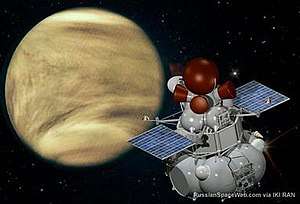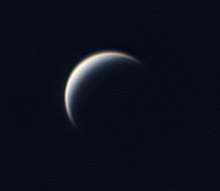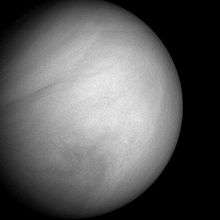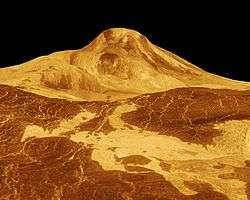Venera-D
 Artist's concept of the Venera-D spacecraft approaching clouds-veiled Venus | |
| Mission type | Interplanetary |
|---|---|
| Operator | Russian Federal Space Agency |
| Mission duration |
Orbiter: ≥3 years (proposed)[1] Lander: 24 h (proposed)[2] |
| Start of mission | |
| Launch date | 2026 (proposed)[3][2] |
| Rocket | Proton or Angara rocket |
| Venus orbiter | |
| Spacecraft component | Orbiter |
| Venus lander | |
| Spacecraft component | Lander |
The Venera-D (Russian: Венера-Д, pronounced [vʲɪˈnʲɛrə ˈdɛ]) probe is a proposed Russian space probe to Venus, to be launched around 2026.[3][2][4] Venera-D's prime purpose is to make radar remote-sensing observations around the planet Venus in a manner similar to that of the Venera 15 and Venera 16 probes in the 1980s or the U.S. Magellan in the 1990s, but with the use of more-powerful radar. Venera-D is also intended to map future landing sites. A lander, based on the Venera design, is also planned, capable of operating for a long duration (24 h) on the planet's surface.
The "D" in Venera-D stands for "dolgozhivushaya," which means "long lasting" in Russian.[3] Venera-D will be the first Venus probe launched by the Russian Federation (the earlier Venera probes were launched by the former Soviet Union). Venera-D will serve as the flagship for a new generation of Russian-built Venus probes, culminating with a lander capable of withstanding the harsh Venerian environment for more than the 1½ hours logged by the Soviet probes. The surface of Venus experiences average temperatures of 462° Celsius (864 Fahrenheit), crushing 90-bar pressures, and corroding clouds of carbon dioxide laced with sulfuric acid. Venera-D will most likely be launched on the Proton booster, but may be designed to be launched on the more powerful Angara rocket instead.
History
In 2003, Venera-D was proposed to the Russian Academy of Sciences for its "wish list" of scientific projects to be included into the Federal Space Program in 2006–2015. During the formulation of the mission concept in 2004, the launch of Venera-D was expected in 2013 and its landing on the surface of Venus in 2014.[5] In its original conception, it had a large orbiter, sub-satellite, two balloons, two small landers, and a large, long-lived lander (24 h). By 2011, the mission had been pushed back to 2018, and scaled back to an orbiter with a subsatellite orbiter, and a single lander with an expected 3-hour operation time.[6] By the beginning of 2011, the Venera-D project entered Phase A (Preliminary Design) stage of development. Following the loss of the Phobos-Grunt spacecraft in November 2011 and resulting delays in all Russian planetary projects (with the exception of ExoMars, a joint effort with the European Space Agency), the implementation of the project was again delayed to no earlier than 2026.[3][2]
Goals
The mission has an emphasis on the atmospheric superrotation, the geological processes that have formed and modified the surface, the mineralogical and elemental composition of surface materials, and the chemical processes related to the interaction of the surface and the atmosphere.[2]
- The orbiter's goals are
- [3]
- Study of the dynamics and nature of superrotation, radiative balance, and the nature of the greenhouse effect
- Characterize the thermal structure of the atmosphere, winds, thermal tides, and solar locked structures
- Measure the composition of the atmosphere, study the clouds, their structure, composition, microphysics, and chemistry
- Investigate the upper atmosphere, ionosphere, electrical activity, magnetosphere, and the gas escape rate
- The lander's goals are
- [3]
- Perform chemical analysis of surface materials and study the elemental composition of the surface, including radiogenic elements
- Study of interaction between the surface and the atmosphere
- Investigate the structure and chemical composition of the atmosphere down to the surface, including the abundances and isotopic ratios of the trace and noble gases
- Perform direct chemical analysis of the cloud aerosols
- Characterize the geology of local landforms at different scales
Potential collaboration
In 2014, Russian scientists asked NASA if the U.S. space agency would be interested in collaborating some instruments to the mission.[3][1] Under this collaboration, Venera-D could incorporate some US components, including balloons, a subsatellite, or a long-lived (24 hours) surface station.[3][2][3] Any potential collaboration is still under discussion.[1][7]
See also
NASA's lander proposals:
References
- 1 2 3 NASA Studying Shared Venus Science Objectives with Russian Space Research Institute. NASA. 10 March 2017
- 1 2 3 4 5 6 Senske, D.; Zasova, L. (31 January 2017). "Venera-D: Expanding our horizon of terrestrial planet climate and geology through the comprehensive exploration of Venus" (PDF). NASA. Retrieved 2017-10-29.
- 1 2 3 4 5 6 7 8 9 Wall, Mike (17 January 2017). "Russia, US Mulling Joint Mission to Venus". Space. Retrieved 2017-10-29.
- ↑ "РАН: запуск "Венеры-Д" состоится не ранее 2024 года". Gazieta.ru. 9 April 2012. Retrieved September 26, 2013.
- ↑ Venera-D mission at Russia Space Web (accessed 25 November 2013)
- ↑ Ted Stryk, Russia's Venera-D mission (DPS-EPSC 2011), Planetary Society, 10/05/2011 (accessed 25 November 2013)
- ↑ Should We Land on Venus Again? Scientists Are Trying to Decide. Meghan Bartels, Space.com. 2 October 2018.



